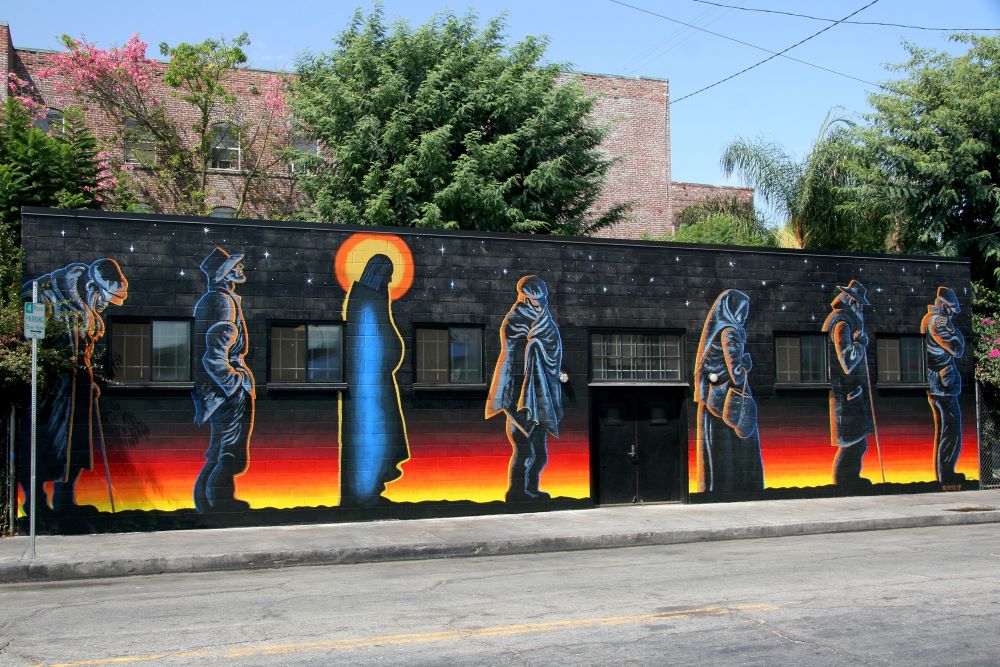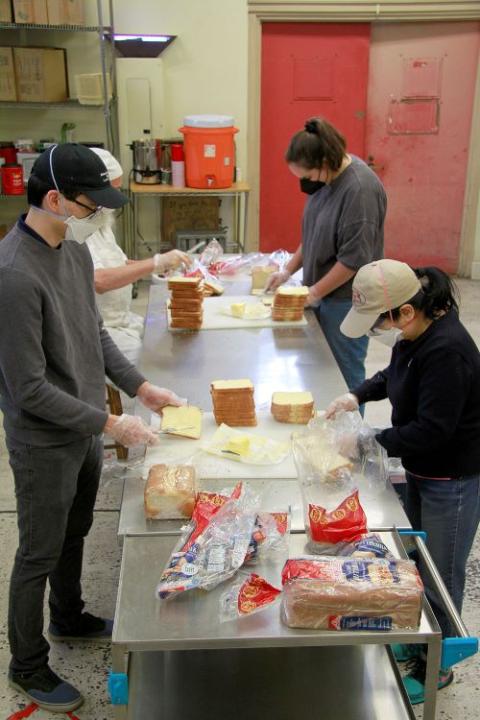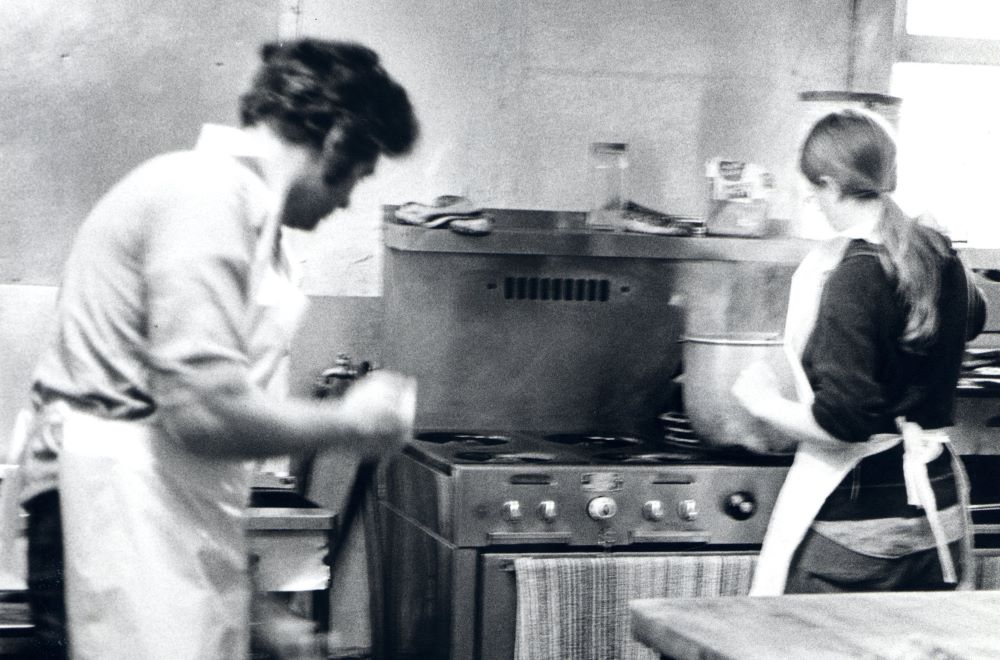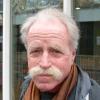
In 1990, Gary Palmatier painted the “Jesus of the Bread Line” mural, an interpretation of an etching by Fritz Eichenberg, on a wall of the Catholic Worker soup kitchen in Los Angeles. (Mike Wisniewski)
Editor's note: This piece is an excerpt from Jeff Dietrich's forthcoming book on his experience with the Los Angeles Catholic Worker.
He rose abruptly, cracking the empty bottle of Thunderbird on the side of the curb. Waving his jagged-edged weapon, he crossed the street toward our soup line. Aubury Robinson, a former lightweight contender, was ready for action. I knew from past experience that I would have to intervene. He took a drunken swipe at me with his broken bottle and I subdued him by force.
It was the only time in my 50 years of defusing Skid Row brawls in and around our Catholic Worker soup kitchen that I have ever laid a hand on one of our guests, much less deliberately intended to hurt them. I am a pacifist by vocation and a non-combatant by natural inclination, but I knew that Aubury "Jack" Robinson was going to attack one of our guests.
When I first came to Skid Row in September 1970, it was much like it had been for 100 years before: a "hobohemia." Not unlike the Bowery in New York City, Madison Street in Chicago and the Tenderloin in San Francisco, it was a classic Skid Row with bars, single-room-occupancy hotels, all-night porn theaters, "flop houses" and evangelical missions serving the mostly white, mostly older, alcoholic inhabitants.
The old Central Station at 5th and Central streets, the heart of Skid Row, was demolished in 1956. But the Greyhound bus station was still at 7th and Los Angeles streets and its facilities attracted drug dealers and derelicts and low-cost "economy" travelers. The convergence of these transportation centers constitute what most urban planners concede as necessary prerequisites for the creation of Skid Rows. And in the early 1970s we experienced a population influx during the winter months as workers returned from harvesting crops, working oil rigs and other seasonal work.

Volunteers work in the Los Angeles Catholic Worker soup kitchen. LA Catholic Worker Jeff Dietrich, who has lived and worked among the poor of Skid Row since 1970, said the work "keeps me in contact with reality when I become too complacent, too comfortable in my own bed." (Mike Wisniewski)
At that time the Catholic Worker was a new entity on Skid Row. I was a recent draft resister, antiwar protester, freshly minted radical, having just read Saul Alinsky's Reveille for Radicals. I didn't want to save souls as the evangelical missions did, I wanted to transform the social environment as Saul Alinsky did. I wanted to "comfort the afflicted and afflict the comfortable," as our founder Dorothy Day did.
We had just recently organized the blood strike, a boycott of the Skid Row blood banks. We formed the Blood Donors Union, which demanded higher payment for donated blood and better health care for donors. We slept in the basement of the kitchen with the strikers and every morning we arose and picketed a targeted blood bank and sent prospective donors across the street to its competitor. We received many threats of firebombing and violence.
Unfortunately, that project only ended up adding fuel to the efforts of the legislature to ban the sale of whole blood in California and the eventual closing of all Skid Row blood banks. But it also led to my appointment to the Citizens Advisory Board of the Community Redevelopment Agency by newly elected Mayor Tom Bradley. My appointment came despite the vigorous objections of Councilman Gil Lindsey, who had called me "a little monkey" in response to my organizing efforts.
Needless to say, as a community organizer and activist I was skeptical of sitting down with a bunch of businessmen and corporate types to give "advice" on downtown redevelopment. At the time the operational plan for the "redevelopment" of Skid Row was the "Silver Book," which called for the wholesale destruction of the entire area and the erection of a library, a USC extension, creation of businesses and luxury hotels.
During a recess of the council hearing on downtown redevelopment, the "Blue Book" somehow appeared on each councilors' desk, detailing an alternative plan that included saving Skid Row housing, creating parks and jobs and a Skid Row Development Corporation. The Blue Book plan was created by the Catholic Worker with the expert help of Jim Bonner, director of the Community Design Center advocacy group. After months of deliberation and negotiations with the business community, it was eventually formalized with the unfortunate designation of a "containment plan" for Skid Row development.
The business community recognized that Skid Row was just too big to relocate, so the "containment plan" was designed to concentrate all social services within the boundaries of Skid Row. Additionally, existing hotels would be rehabilitated and a nonprofit created to operate them that would include in-house social services. The largest evangelical mission, the Union Rescue Mission, would be relocated from Main Street to the center of Skid Row at 6th and San Pedro Street.
But there was a tradeoff. Police would be allowed to ticket panhandlers when they migrated into the business center, thus diminishing the deleterious effect of the Skid Row poor. If that sounds like a Faustian bargain, it was. But it allowed the business center to flourish, and it allowed Skid Row to grow as an Ellis Island reception center to LA's prodigiously expanding homeless population.

Community members work in the soup kitchen of the Los Angeles Catholic Worker in 1977. (NCR photo/Patty Edmonds)
Sometime around the mid-1980s the first Skid Row homeless encampment sprang up in the vacant lot next to the Catholic Worker soup kitchen. As this population expanded we began to focus on essential services to the growing sidewalk encampments.
Our first campaign was to provide port-a-potties to a community of people who were doing their personal business on the streets, between parked cars and behind dumpsters. We were arrested numerous times for sitting in at the mayor's office, blockading city council members' bathrooms and disrupting business meetings. After years of campaigning we were finally successful when Mayor Richard Riordan allowed 30 port-a-potties to be installed in Skid Row.
We followed that success with our shopping cart campaign, in which we initially bought 100 shopping carts to be distributed to the homeless. We held a press conference and a shopping cart parade at Central Division police headquarters, in which we publicly exposed illegal police actions. They would first write out a ticket to any homeless person on Skid Row pushing a shopping cart, claiming the car had been stolen. Then the officer would push the cart into the middle of the street and dump out the contents, often recyclables as well as personal property, sleeping bag, tent, personal identification, prescriptions and medications. A skip loader would then scoop up the cart and its contents and crush them.
We once wondered to a friend, "Why is it illegal for a homeless person to push a shopping cart and it is NOT illegal for a police officer to crush that very same shopping cart?" Our friend responded: "Someone should buy homeless people shopping carts."
The only people we knew who would be crazy enough to buy shopping carts for homeless people was us, the Catholic Workers. Since that first distribution of shopping carts in front of the police department we have given more than 100,000 shopping carts to homeless people on Skid Row.
Advertisement
One could easily dismiss our project as insane, but it meets the needs of homeless people where they are actually situated in real life. I have seen people turn our carts over, put a tarp on top and sleep inside. The homeless are daily harassed and told to "move on." To do so, they need to be able to move their meager possessions to the next location. They also use our carts for recycling, to earn essential income.
As Skid Row continued to evolve from one homeless encampment into the squalid Beirut and Baghdad refugee encampments of today, we took our fight to the courts. Along with help from civil rights attorney Carol Sobel, we won the constitutional right of homeless people to "security in their property and possessions." We also won the constitutional right of homeless people to be free from the "cruel and unusual punishment" of police harassment and jail time for the "crime" of sleeping on the sidewalks until such time as the city provides additional low cost shelter or housing for them.
As more and more areas of our city — indeed our entire country — begins to look like the tent cities of Skid Row, we must realize that the expanding American economy has left behind and abandoned a significant population to the status of homeless refugees.
Shopping carts, blood strikes, port-a-potties. These are but a handful of efforts over the years that represent the spirit of the Catholic Worker community working to impact the social environment of Skid Row. But the core of our work has always been the soup kitchen: feeding hungry people, creating a sense of welcome, conviviality, dignity and listening to their stories in our beautiful dining garden.
Skid Row is my anchor to the suffering world. It keeps me in contact with reality when I become too complacent, too comfortable in my own bed with a roof over my head and hot food on my plate. It is my own personal Afghanistan, Iraq, Vietnam. It is my own personal war zone. It is my refugee camp that keeps me honest when plagued with personal and ideological delusions.
Above my writing desk hangs a picture of Arbury "Jack" Robinson, cut from the LA Times, warming his hands over a trash can fire during a long ago cold spell. I think of him often, and fondly. Despite his unruly behavior, I think of him as an icon of Skid Row. He was, as Simon and Garfunkel sang, "a boxer and a fighter by his trade, and he carries the reminders of every glove that laid him down or cut him till he cried out in his anger and his shame, 'I am leaving, I am leaving,' but the fighter still remains."
I hope I have been that fighter who remained anchored to my own personal war zone and refugee camp fighting for Jack Robinson and all the boxers of Skid Row.








